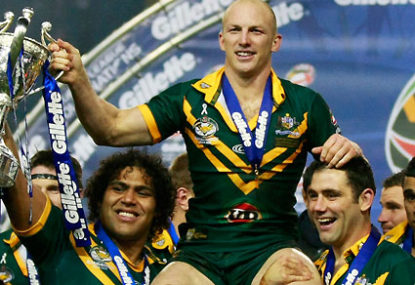The greatest game of all, rugby league, is unique. It’s painful. Its seasons are long. Careers can end in a single tackle.
In this article we’re putting aside concussion (which the league is now belatedly addressing).
We’re talking about Andrew Johns winning the 1997 grand final with a punctured lung. Shane Webke’s 2000 grand final performance with a broken arm. Robbie Farah’s Origin 1 efforts this year with a separated shoulder.
Many of the game’s celebrated stories are about overcoming injury. John Sattler may have played four Tests, and won four premierships, but he’s best remembered for having played the 1971 grand final with a broken jaw.
When we saw this repeated by Sam Burgess two generations later, however, reactions were mixed. Some celebrated his bravery. Others lamented it. Some noted the game’s legal exposure.
Can an employer ask an employee to face such risk, even if they chose to do so?
Sacrifice has always been expected. Picture Dylan Walker playing on with a broken hand in Round 3. While he would later need a month to heal, he stayed on, impaired and in pain. His teammates responded.
“It’s pretty inspirational what he did, and to come out and score two tries is pretty special,” enthused emerging forward Chris Grevsmuhl to the Telegraph‘s Christian Nicolussi.
“He’s a tough kid who is mature beyond his years. It’s not the first time he’s played with injury,” added Tim Grant.
Burgess’s grand final adversary, James Graham, personifies the old school approach, publicly opposing the ban on shoulder charges, concussion rules, or independent doctors.
“We know what the risks are. Why does a doctor tell me I can’t go back on?” Graham asked. “Why can’t that be my choice?”
It’s not just individual players struggling to adapt. Some clubs have been outright recalcitrant. Graham’s Bulldogs have been fined for repeated breaches. The Tigers and Cowboys followed. Incredibly, the Eels were investigated for mishandling head knocks for Nathan Peats, Will Hopoate and Isaac De Gois in a single game this year against the Warriors.
It’s time clubs faced two costs.
Ending careers
Consider Anthony Watmough. His high profile move to the Eels has been cruelled by injury, but he’s forced to play through by a mismanaged salary cap. Before his landmark 300th game he spoke openly about his injuries.
“I’ve torn biceps off the bone,” Watmough said. “I need to get my knee injected every game just to play. My shoulder injected. My fingers go numb every game. That’s just what we do as a sport. It’s a brutal sport, a collision sport.
“We do it because we love it and it’s something I wouldn’t change.”
But at what price? At age 31, despite signing a three-year deal, he is unlikely to match past glories. While he retired from Origin football this year, he did so after being overlooked.
This star, who once achieved 173 tackle busts in a season, may never match these performances again.
Permanent injuries
The league has an obligation to all its players – especially its most vulnerable. Those already injured. Juniors. Those on second-tier contracts, or facing renewals.
It’s time for leadership. Enter Darren Lockyer.
In his testimonial year in 2011, he faced a dilemma. Despite needing three titanium plates inserted for a shattered cheekbone, he was set to play just five days later.
“The plates they have put in will be enough to keep the cheek strong enough,” he claimed in a Fox Sports interview with Chris Garry. Opinion varied though. Former Kangaroos doctor Nathan Gibbs sent a clear message that he risked his eyesight by playing.
Most bravely of all, Darren declined to play. It was the right decision.
He’s remained a leader since. In 2014, when Israel Folau faced a throat injury similar to his own, he urged him not to play.
“I never saw a doctor about my throat injury until years later,” Lockyer told The Australian‘s Wayne Smith.
“I never realised the severity of my injury at the time. It was when I noticed that my voice wasn’t returning to normal that I knew something was wrong.
“But it wasn’t until I was getting an X-ray for a broken cheekbone that the damage to my throat was also discovered. Back then, unless there was concern that you had a broken limb, you didn’t get sent away for X-rays.”
While we can celebrate players’ bravery, we owe them more than this. More for their families and for their lifelong well-being.
Is your club changing its culture to offer players the protection they deserve?






























































































